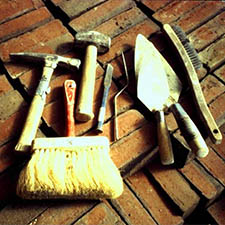Matching Old Mortar Matters, Says Mason
TMS received its 34th post this morning from J. Dennis Robinson, Portsmouth’s historian. Who knew that the mortar could be so important when restoring old brick structures? Apparently Master Mason John Wastrom did!
I live in a little brick house by a river. It looks just like the house that sheltered the Three Little Pigs from the Big Bad Wolf. He huffed and he puffed, but he could not knock it down.
Something about brick feels safe. It feels ancient and sturdy and durable. Portsmouth has become obsessed with its brick image downtown. Next we may see red brick parking meters and red brick street lamps.
So I was surprised to learn that, back in the 19th century, a lot of downtown buildings were colorfully painted. Red brick was not considered classy. So instead of a monochromatic downtown, historically, we should paint our brick buildings different colors instead of sand-blasting the surfaces to look all the same.
Master mason John Wastrom of Rollinsford, NH told me a lot about brick during a three-hour phone conversation a few weeks back. He should know. John has had his hands on just about every historic chimney, brick wall, and stone foundation in the region. He worked on the 1710 Weeks Brick House in Greenland, at Strawbery Banke Museum and the 1715 Warner House in Portsmouth, and at the imported Yin Yu Tang Chinese home in Salem. He’s learned a lot over the decades about preserving historic buildings. John also has a degree in archaeology and another in conservation. And he isn’t shy about sharing his opinions.
Most important, John says, is that brick structures built before the 1930s probably are held together with mortar made from lime. Our ancestors had hundreds, even thousands of years to learn how to mix mortars. Masons knew their craft and used local materials. The mortar was sacrificial, John says. It was designed to powder and to be replaced. But according to John, historic brick and stone structures should be repaired with historic mortars. That is, the new mortar mix needs to match the original mortar mix.
This is no big deal when it comes to modern structures, where the brick is often just the outer skin of a wooden or metal frame. Those buildings have all been built with “Portland cement,” a British invention, that includes an epoxy. But the components of modern mortar can actually be harmful when used to restore older structures, blocking their pores, preventing them from breathing or being porous.
Okay, I don’t really understand all this. But I live in an old brick house, built in 1919, and I want it to keep me safe from the Big Bad Wolf for decades to come. So I need to find out what mortar was used in 1919, so I can mix the mortar when the house needs repair. At least now I know who to call.
READ MORE: “The Truth About Bricks and Mortar”
http://www.seacoastnh.com/History/History-Matters/the-truth-about-bricks-and-mortar/
- Dennis Robinson is editor and owner of the popular website SeacoastNH.comand author of 12 books about history. His latest release is MYSTERY ON THE ISLES OF SHOALS: Case Closed on the Smuttynose Island Ax Murders of 1873. You can follow his history postings on Facebook. His newest website is www.SmuttynoseMurders.com

